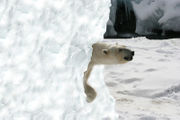Global Cooling
“The glaciers that were once melting are now on the attack.”
– Al Gore on Global Cooling
The Global Cooling Crisis of the 25th century was a planetary emergency caused by the elimination of greenhouse gases. As the Earth began to revert to its former temperature, there became widespread concern about the ability of the human race to reverse the adjustments it had made during the 21st century Global Warming crisis.
World in Crisis
The most outspoken groups were:
- Oceanside cities that feared their ports would become grounded as water levels sunk.
- Northern fishing communities fearful of dangerous ice floes and colder climactic conditions.
- Field hockey players who did not know how to skate.
- Owners of "Heat Wave Resorts" who feared record losses if people were no longer desperate for their air-conditioned mini-worlds.
- People whose energy needs had become reliant on hurricane power.
- Religious leaders who needed the fear of a human-created climate apocalypse to get recruits in an increasingly non-religious world.
- Polar bears were unpleased with either climatic condition. Their ancestors were stuck on icebergs due to global warming; now they kept getting stuck in ice.
These problems resulted in the Iqaliut Protocol of 2422. The world's nations were urged to meet their Iqaliut carbon emission targets by reverting to coal- and oil- based fuels. This created friction in a world where wind, solar, tidal, and hurricane power had become so well-established that the political will to create old and non-innovative solutions was clearly lacking.
Nonetheless, numerous innovations became commonplace by the mid-25th century:
- New "Eco-cars" known as "DumbCars" (using oil-based fuels).
- Recycling and composting gave way to the creation of "garbage"
- New 20th-century-style "steel towns" - the historical significance was of great interest to tourists, providing incentive for cities to "go black."
- Drive to work week
Iqaliut controversy
Not everyone was pleased with the idea of addressing climate change. Business groups complained that increased emissions would be catastrophic - to the economy. Factories complained bitterly at the prospect of polluting more. They began to cite early-21st century arguments that emissions were harmful to the environment, a subject about which they all became suddenly quite concerned.
In particular, some nations argued strenuously at the requirement of increasing emissions to 2046 levels by 2435. Countries with long coastlines such as Russia, Canada, and Nepal had become completely dependent on tidal power; while the Netherlands feared economic collapse if sales of their Classic Dutch-Style Windmills were to fall. Far-north nations argued that their targets should be reduced to compensate for an expected southward migration of retirees and weather wimps as the climate cooled. Heavily-populated countries argued that their targets should be reduced because they had so many people depending on clean power. Countries with small populations argued that their targets should be reduced because they did not have the labour to rapidly develop oil- and coal-based energy.
Proponents of emission increase included equatorial and desert nations such as Saudi Arabia, Venezuela, and Kuwait, which urged the world to help reduce the effects of their devastating heat waves. Environmentalists, though a bit confused, eventually agreed to "find the cleanest possible ways to increase pollution."
Old habits die hard
But it was hard to get people to change old ways. After centuries of practicing energy conservation, many people stubbornly refused to let their lights burn all night, leading to criticisms that they were not lazy enough to not get up and turn them off. Others had become accustomed to modern conveniences such as "beaming" everywhere, and were chagrined at the prospect of having to travel by automobile. Teenagers in particular rebelled against their parents' insistence that they learn to drive. Due to the urgency of the climate crisis and a desire to educate people when they were young, many 16-year-olds were required to take driving lessons and in some cases were given their own cars - when they would much rather have been studying interesting things such as Biology, History, and Math.
Blue-collar labour was particularly hard to find in a world where most physical tasks had become automated. Robots refused to work in coal mines, citing unacceptable hazards and damage to their lungs. When confronted with the fact that they did not have lungs, striking robot activists insisted that they had the same rights as everyone else regardless, and that they were already given a much higher percentage of the manual labour jobs than other people (the response "but you aren't people" was not considered robotically correct). The eventual compromise (not that the strikers had been fabricating arguments purely for more money) made robots the wealthiest beings on the Earth. Historians agree that this was a major cause of the 26th century robotic revolution, with its artificial intelligence empires, neo-feudalistic societies, and human "Take Back the Earth" marches.
The global cooling boom
Climate change brought economic benefits: oil rigs, oil- and coal-powered machines, and conversion to fossil fuels all provided employment opportunities. The world's poorest nations in Europe and North America improved their economies by providing equipment and fuel for wealthy nations such as China and India. Charitable organizations such as the "Help Destroy a Windmill Foundation" and the "Deforestation Club" contributed to the boom.
Many individuals enjoyed the newly-created superbeaches as coastlines receded. Partly eroded structures from previous coastal societies became huge tourist attractions. Visitors could see the ruins of ancient Tokyo or become lay archaeologists digging up computers and television sets of old. In Mumbai, one could study building patterns and erosion to identify the year each

part of the city had been evacuated as water levels rose.
The Cool War
The boom brought with it new tensions as well. The "combat global cooling" corporations were at odds with those businesses that benefited from cooling. Each side donated large sums to respective political parties that supported its cause. The resulting divide in ideologies led to the Cool War, not a real war but a metaphor for the standoff between conflicting factions. An arms race ensued in which each side controlled millions of Thermo Humungous Energironic Extreme Nuclear Devices, a single use of which would have destroyed the entire world. Fortunately, this did not occur. Both sides eased up on their dogmatic stands and self-interests, which resulted in a surprisingly easily-reached solution.
What Are You Doing to Prevent Global Cooling?
What can you in the 21st century do? (next to purchasing large tracts of real estate in Greenland, and selling them off at substantial profit in the 24th century). You could prevent global warming so that the Earth does not need to revert. If you wanted to. But after all, the effects are far in the future, and why should anyone be worried about them today?
Stay cool.







